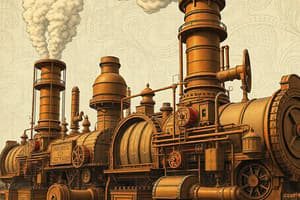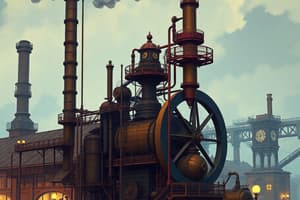Podcast
Questions and Answers
What is the purpose of the slide valve in the engine cylinder?
What is the purpose of the slide valve in the engine cylinder?
- To transfer the reciprocating motion of the piston rod to the crankshaft
- To control the steam pressure from the boiler
- To convert rotary motion to reciprocating motion
- To admit and exhaust steam from the engine cylinder (correct)
Why is the engine described as 'double acting'?
Why is the engine described as 'double acting'?
- Because it uses steam expansively throughout the entire stroke
- Because it allows steam to escape through the underside of the slide valve
- Because it produces power on both the upward and downward stroke (correct)
- Because it continuously admits steam throughout the entire stroke
What term is used to describe cutting off the steam supply and allowing the steam in the cylinder to expand?
What term is used to describe cutting off the steam supply and allowing the steam in the cylinder to expand?
- Expansive use of steam (correct)
- Steam expansion
- Steam admission
- Steam conversion
What component of the engine is described as 'eccentric' or 'off center' with respect to the crankshaft?
What component of the engine is described as 'eccentric' or 'off center' with respect to the crankshaft?
What is the purpose of lubricators in the engine?
What is the purpose of lubricators in the engine?
What is the function of the crosshead in the engine?
What is the function of the crosshead in the engine?
What has contributed to the nearly obsolete status of steam engines?
What has contributed to the nearly obsolete status of steam engines?
In what situation are steam engines still used today?
In what situation are steam engines still used today?
What is the construction type of the steam engine described in Figure 2?
What is the construction type of the steam engine described in Figure 2?
What component of the steam engine discharges lubricating oil with exhaust steam?
What component of the steam engine discharges lubricating oil with exhaust steam?
Where are steam engines rarely seen in service today?
Where are steam engines rarely seen in service today?
What part of the steam engine is responsible for controlling the admission of steam to the cylinder?
What part of the steam engine is responsible for controlling the admission of steam to the cylinder?
What is used to squeeze the packing tightly into the box around the rod?
What is used to squeeze the packing tightly into the box around the rod?
What is fitted into the lowest part of the cylinder and valve box for the removal of water caused by steam condensation?
What is fitted into the lowest part of the cylinder and valve box for the removal of water caused by steam condensation?
In most steam engines, when does the admission of steam stop?
In most steam engines, when does the admission of steam stop?
What regulates engine speed with the change in load requirements?
What regulates engine speed with the change in load requirements?
What is often fitted to dampen or even out the changes of speed caused by varying steam pressure and loads?
What is often fitted to dampen or even out the changes of speed caused by varying steam pressure and loads?
What does the frame of the steam engine provide?
What does the frame of the steam engine provide?
What does a small vertical single cylinder, double-acting steam engine have in its steam chest?
What does a small vertical single cylinder, double-acting steam engine have in its steam chest?
What needs to be cleared from flywheels, pulleys, drive belts, and other moving parts before starting a steam engine?
What needs to be cleared from flywheels, pulleys, drive belts, and other moving parts before starting a steam engine?
Flashcards are hidden until you start studying




